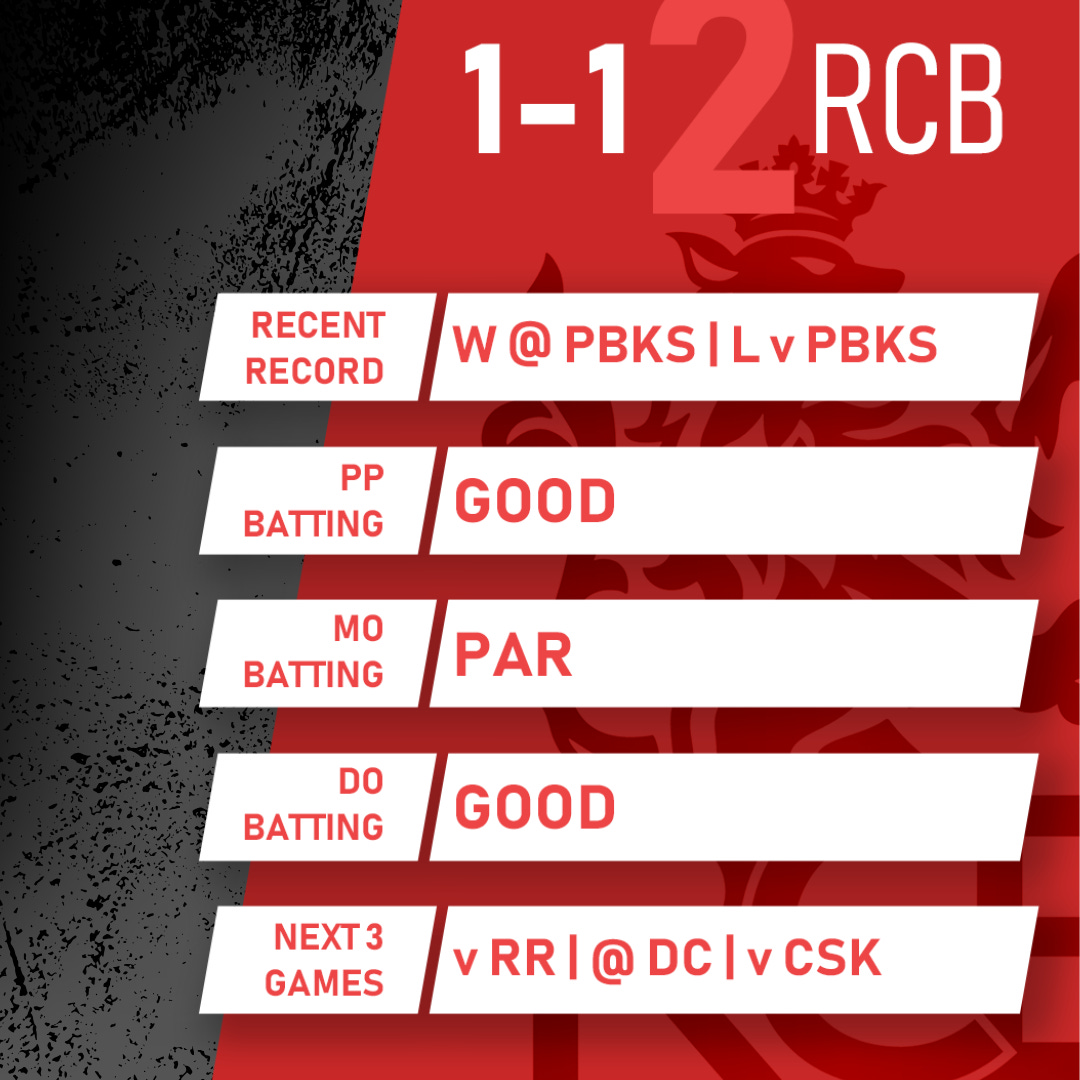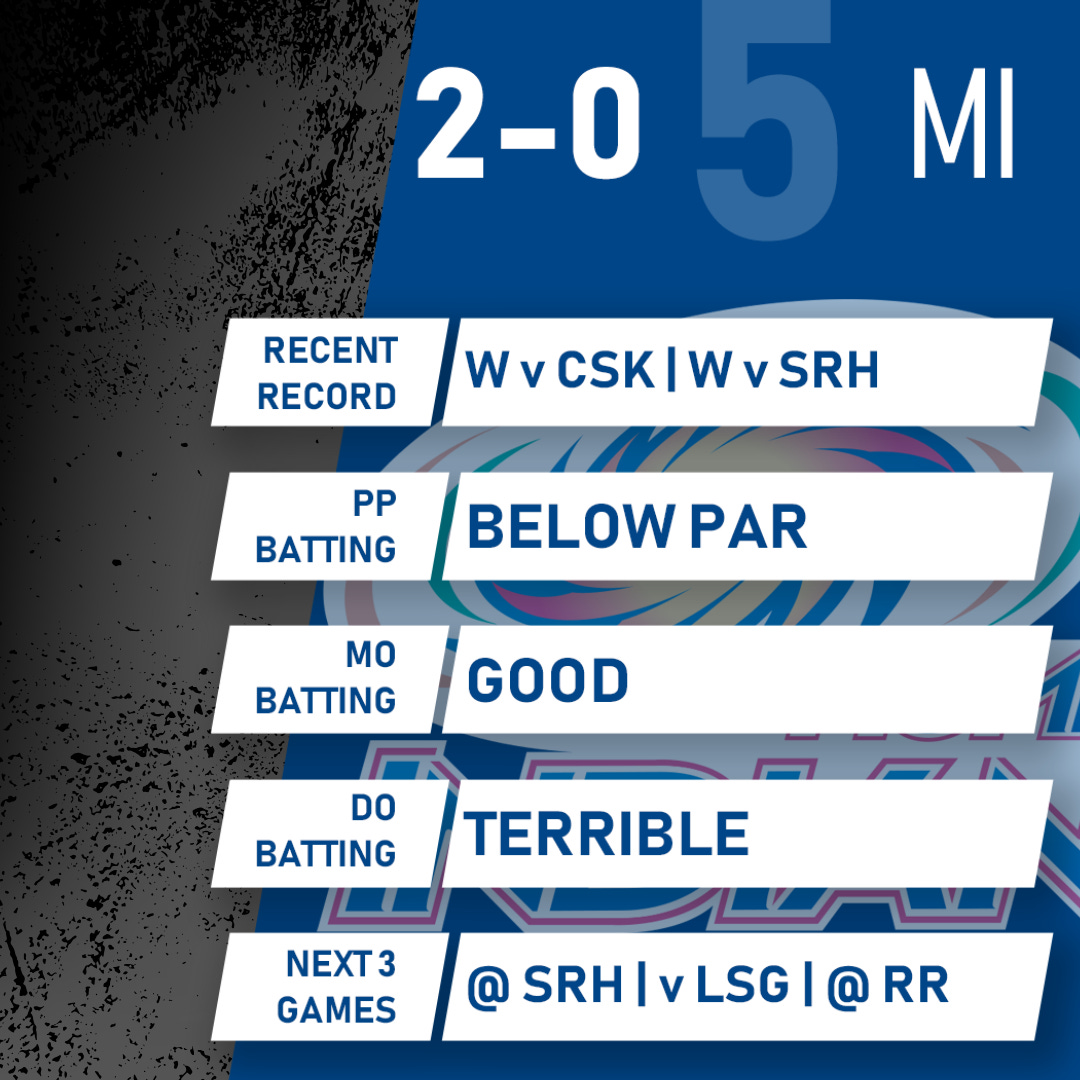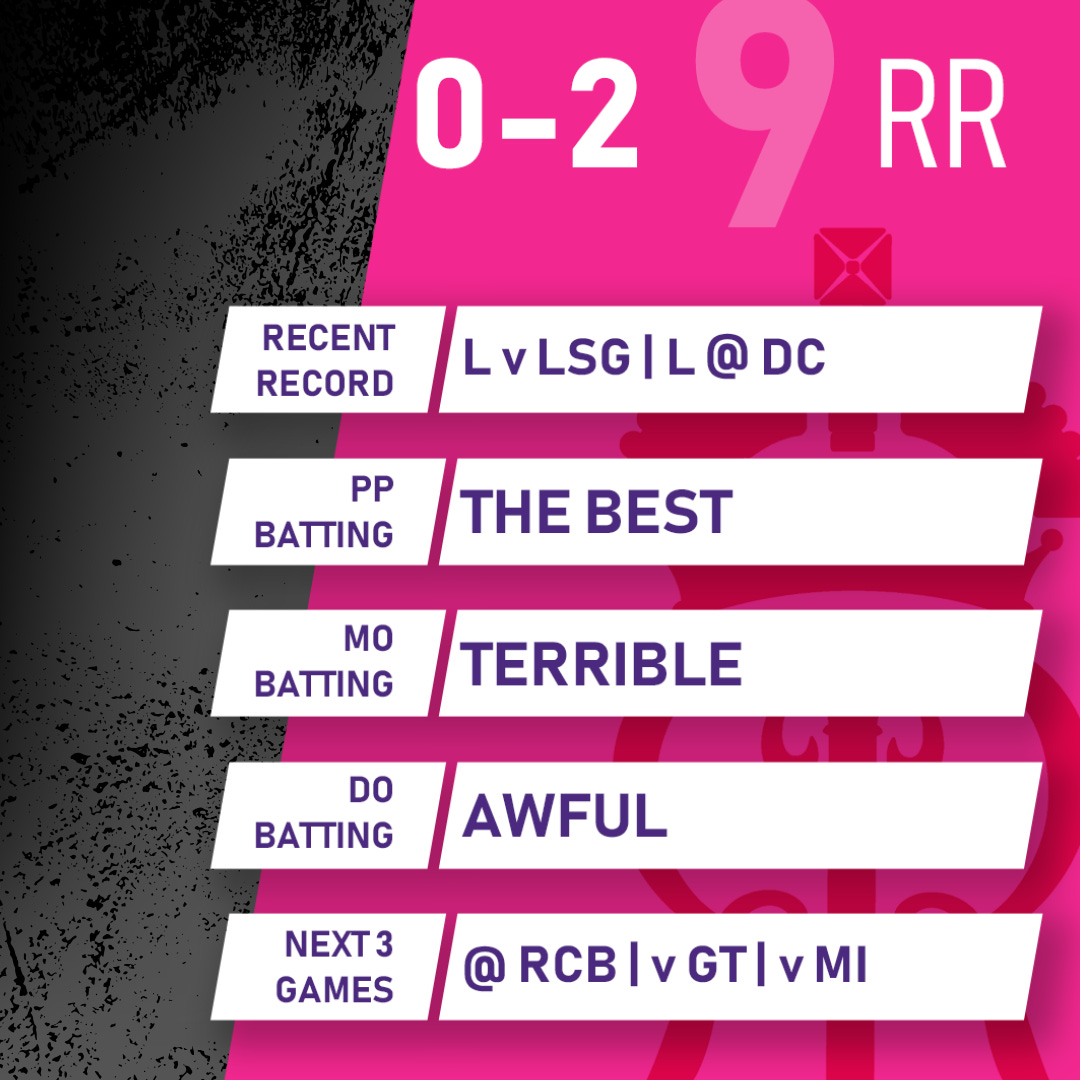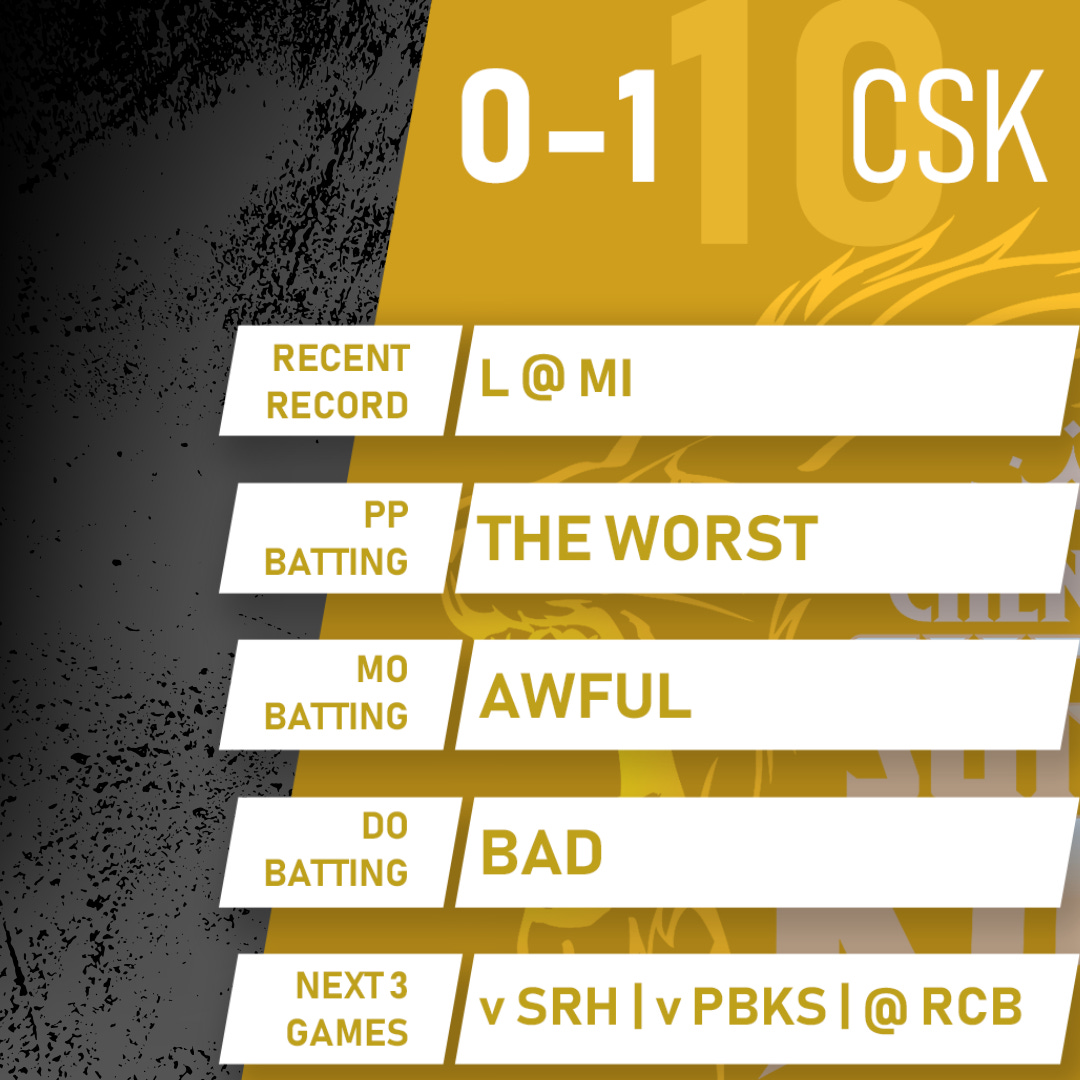IPL 2025: Power Rankings - Episode 4
Today, we look at each team’s batting.
We are offering a 30% off deal for Art of Batting. Just click this link and use the code GOODAREAS30 at checkout. This works for orders and pre-orders. It’s a global discount, so it will work across Australia, Canada, India, UK and US sites.
We are at the halfway point (or past it, or really close to it) of the IPL. So these are the first emotionally truthful power rankings. I mean it’s still us just throwing crap at a wall, but now we have dissected the feces afterwards.
The rankings are not a points table; one of those always exists. We’re looking at the strength of schedule, recent form, the next matches, and then making up a list from there.
Today, we look at each team’s batting.
GT
Gujarat chased down a total of over 200 against Delhi and then defended 198 against Kolkata. They lost only six wickets combined in both the games, as their top-order has been ridiculously consistent while still scoring quicker than anyone else in the league.
Their powerplay batting has been incredibly consistent. Although they are a bit slower than the other teams, they make up for it by losing barely any wickets at the top. Plus, they have a very high floor – so there haven’t really been games where their batting against the new ball has put them massively behind the game. Sai Sudharsan averages 203 at a strike rate of 148, those sound like made up numbers. Shubman Gill is at 39 and 144.
But the real deal is their middle overs batting. They start accelerating and are among the best teams in the competition in terms of both average and strike rate in this period. Jos Buttler has a strike rate of 170 from overs 7 to 16, while averaging 129. Sai’s numbers are 38 & 153, while Gill’s are 64 and 158. That is the engine room of their batting success.
They’re also yet to have a bad game at the death. Though they couldn’t chase 62 off the last 4 overs against Punjab, they still ended up making 50/3. So they either finish games early or do a good job in this period of the game. Sherfane Rutherford has faced the most deliveries (53), averaging 17 at a strike rate of 157. Buttler has been elite in the limited sample size of 29 balls, scoring at 12 runs per over.
They now play two out of form sides in RR and SRH next. It could be the perfect opportunity for them to get even closer to a top two finish, which is the ideal outcome at the end of the league stage.
RCB
RCB’s perfect record of 100% wins away and 100% losses at home continues. They were dangerously close to breaking their 49 all-out record in the home game, but Tim David played a special innings and the bowlers put up a good fight with the ball. They chased down 158 in Mullanpur.
Phil Salt has been absolutely destructive in the powerplay, striking at 185 and hitting a boundary less than once every three balls. Virat Kohli has done well playing second fiddle to him, getting out just twice and striking at 148 in this phase. Devdutt Padikkal also stepped up and batted with intent against MI and PBKS when Salt got out early.
Their middle overs batting has been a bit more of a mixed bag. They’re fine while chasing, with Kohli dropping anchor and staying there till the end. But they have now failed in the middle period thrice at home – all in the first innings. However, batting first was not a problem in Chepauk or Wankhede. Rajat Patidar (159 runs at 40/154) has been RCB’s most crucial batter in this period. Liam Livingstone’s form was a bit of a concern, and he was dropped for Romario Shepherd in their last match.
In a role as volatile as that of a T20 finisher, Tim David is yet to fail for RCB in a single game. He has scored 85 runs off 39 balls and been dismissed just once from overs 17 to 20. He has basically ensured that RCB were able to perform in this period almost every time.
They now play Rajasthan and Chennai at home, and Delhi away. So they are up against two teams woefully out of form in home conditions where they have struggled, while they play the stronger team on the road. On paper, it sounds like the ideal run of games for them.
DC
Delhi won a super over against Rajasthan after the latter required only 9 runs in the last over. Mitchell Starc bowled a brilliant 20th over. It came down to 10 required off 6 balls in their next game, but Rahul Tewatia finished it off in two balls.
DC were 58/4, 39/3 and 46/2 in the first six overs versus LSG, RCB and RR respectively. But they have had a couple of great outings in the last three games thanks to Karun Nair, who has scored 69 runs at more than two runs a ball in the powerplay.
They seem to have cracked the formula of scoring quick without losing too many wickets in the middle overs. KL Rahul (170 runs at 57/160) has been the standout batter, while the others have also chipped in.
At the death, DC have had three great performances, two decent ones and one bad outing versus MI. Their two best performers with the bat in the final four overs have been Ashutosh Sharma and Tristan Stubbs. Remember, Ashutosh bailed them out of trouble in their first match of the season against Lucknow.
Their road ahead isn’t exactly a walk in the park, but they have defeated Lucknow and Bengaluru earlier in the season. Kolkata have a 3-5 record, but their form hasn’t been as bad as some of the other teams.
LSG
Despite Mitchell Marsh and Nicholas Pooran failing, they were able to post 180 thanks to Aiden Markram, Ayush Badoni and Abdul Samad. After they didn’t have much of a chance in the second innings, Avesh Khan’s yorkers at the death won Lucknow the game.
In the powerplay, Marsh scores at 10 runs per over while averaging 87.5 – combining speed with frankly a ridiculous level of consistency. Markram has been pretty solid too, averaging 40 and striking at 154. Pooran has also been very good in this phase.
But Pooran really bosses the middle overs. If there isn’t a significant drop off in his form, he’s well on course to have one of the all-time great seasons. He averages almost 50 while scoring at well over two runs a ball. This would have sounded unbelievable a few years ago. The other batters with over 100 runs in this phase are Marsh (25/170), Markram (37/149) and Badoni (43/127). Rishabh Pant is in the middle of a terrible season, so if he can pick up some form that would potentially make them even stronger in this phase.
Abdul Samad has been their quickest scoring batter at the end of games – 72 off 34 balls, 4 dismissals. David Miller has faced the most deliveries, but his strike rate is a little less than 150.
They have a pretty challenging set of fixtures coming up, but if they can go on a winning streak here it’ll set them up well in what looks like a very competitive league at the moment.
MI
Mumbai are back to winning ways after a slow start. Both their home games resulted in comfortable wins, as they opted to chase after winning the toss both times. They’ve clearly broken out of the SRH-RR-CSK tier.
Before the CSK game, Rohit Sharma was in terrible form. He still averages only 19 at a strike rate of 152 in the first six overs, going not out only once. Ryan Rickelton has spent the most time at the crease in this phase, scoring 155 runs at 39/145 and hitting a boundary once every 3.8 deliveries.
After the first two games, they’ve been pretty solid through the middle phase. There have been occasions when one or more of their batters have gotten stuck, but that hasn’t been an issue in the last three wins. Suryakumar Yadav averages 56 at a strike rate of 175 between overs 7 to 16 this season. Tilak has also been a consistent run-getter, though his strike rate of 140 is slightly on the lower side relatively.
They haven’t really been that great in the death overs. Naman Dhir’s strike rate of 186 is the highest of all their batters, and they’ve scored at 10 runs per over or less in four of the five innings.
A 2-1 split in the next three games is definitely not out of question. Two of their next three upcoming games are versus RR and SRH. If they win those two and lose to LSG, they’ll have 6 wins out of 11 – which would put them in contention for a top 4 spot. But 3-0 would obviously be ideal for them, and defeating LSG also means another team that is in the playoffs race doesn’t get the two points.
PBKS
After their bowling struggled a lot in the first five games, they’ve pulled things back in recent times. But on most days, they would have lost the KKR game. After reducing RCB to 42/7, the rain-shortened game got to a point where they still needed 43 off 32 with six wickets in hand. But Nehal Wadhera did well to finish it off. Batting first at home, they started off well in the powerplay, kept losing wickets in the middle, and faced some brilliant death bowling.
Priyansh Arya (199 runs at 33/199) and Prabhsimran Singh (184 runs at 46/177) have been intent monsters at the top of the order. Punjab have crossed the 70 mark thrice, while scoring less than 50 only once.
Apart from their last two full 20-over matches, they have always scored at 9 runs per over or more from overs 7 to 16. A big reason for that has been Shreyas Iyer, who has struck at nearly 175. Nehal Wadhera has been their top run-getter in this phase of the innings. But they have been quite reliant on those two.
Shashank Singh has been the main man at the death, scoring 83 off 49 balls without being dismissed. Iyer made 54 runs off only 18 balls, Marcus Stoinis also had a strong finish against SRH, and Marco Jansen did well against CSK.
They now play two away games against KKR and CSK. Their remaining home games are at Dharamsala, so they’ll have to adapt to the conditions on offer at that venue.
KKR
Kolkata have had the worst kind of losses in the last couple of games. They were 62/2 in 7.3 overs while chasing 111 against Punjab, and the rest is history. After that, they lost to Gujarat by a significant margin despite Angkrish Raghuvanshi helping a bit with the net run rate towards the end of the innings.
I honestly have mixed feelings about their powerplay batting this season. It was a key driver of their success last year, but Quinton de Kock has just not had a good run of form – playing just one noteworthy knock. They have had a couple of terrific starts versus Lucknow and Chennai, and they were 41/4 against Mumbai. Apart from those outliers, they’ve more or less been alright. Ajinkya Rahane averages 155 at a strike rate of 178, clearly the standout batter for them. Raghuvanshi has done pretty well too, while Narine’s form has been a little patchy – three good starts and four scores less than 20.
But the middle overs are where they’ve lost games with the bat. Their issues against spin have been there to see for everyone, mostly notably in the Punjab game we talked about earlier. They have lost five wickets in three other games too. None of their batters with at least 50 runs in this phase of the innings averages over 25 or strikes above 130.
I don’t have much to say about their batting at the end of games. They’ve played the full death overs just four times. They struggled against RCB, did really well against SRH, were decent against LSG and the last game was basically done once Andre Russell was out.
They are still in the competition, but their next two games are challenging. If they can go 2-1 in the next three, they’ll have 5 wins in 11 games. So playoffs wouldn’t be impossible, but they would require other things to go in their favour as well.
SRH
SRH had a very uncharacteristic batting powerplay versus MI, scoring only 46 runs but without losing any wickets. Travis Head couldn’t get going, and Abhishek Sharma or Heinrich Klaasen didn’t score at breakneck speeds either. MI were able to chase it down comfortably, with contributions from multiple batters.
They’ve had two spectacular performances in the powerplay, and were good against Lucknow as well. But in most of the other games, they’ve lost a lot of wickets. Travis Head has been averaging over 50 at a strike rate of 174, while Abhishek Sharma is at 27 and 165 respectively.
It is a similar story when we talk about the middle overs. They made 125 against RR and 135 versus PBKS, losing just a combined three wickets in the two innings. But in every other innings, they’ve lost three wickets twice (and scored at a run rate in the 6s), four twice and six once. Nitish Reddy and Heinrich Klaasen have been far from their best. Aniket Verma has shown a lot of promise; hitting sixes at will versus spin.
SRH were already 8 and 9 down in two games by the time the death overs even started, and they finished the chase against Punjab with 1.3 overs to spare. So if we look at the other games, they made 67/3, 34/3, 44/3 & 50/2.
Mumbai can longer be considered an easy team to defeat, as they’ve won three games on the trot, and Gujarat have had a solid season so far. Both these teams have also defeated SRH earlier in the season.
RR
Rajasthan have now lost two matches where they required 9 runs off the final over. They lost in a super over against Delhi, and fell short by two runs against Lucknow in a game that felt in control for the most part.
RR have been the best powerplay batting side. Their average score in the powerplay is 61, and they’ve only lost seven wickets in eight innings – three of which were against SRH while chasing 287. Yashasvi Jaiswal has scored 164 runs at 55/145, while Samson has 147 runs at a strike rate of 150 and has gotten out just once. Every other RR batter who has come in to bat in this phase has scored quick runs.
However, the slowdown begins in the middle overs. They’ve never scored at over 10 runs per over in this phase. Jaiswal and Parag both have over 100 runs in the 10 overs after the powerplay, while striking at 136 and 130 respectively. Now, there’s definitely an element of Jaiswal playing longer in chases this season, but the problem is that nobody has been consistently quick in this period for Rajasthan. Dhruv Jurel (28/121) and Sanju Samson (15/133) have not performed well at all. Nitish Rana has a strike rate of 157, but he averages only 24. Shimron Hetmyer has scored 76 off 52 balls, getting out just once. But he’s a finisher who primarily comes in at number five or six.
And Hetmyer has 100 runs at a strike rate of 159 at the death – which is sub-par considering how teams are regularly scoring at over 10 runs per over then – while averaging only 17. Jurel has scored 84 runs at a strike rate of 183, but he couldn’t take the team over the line in the last two games.
They are playing three in-form sides next, so making a comeback for a late playoffs charge will be quite tricky.
CSK
Chennai lost to Mumbai by 9 wickets and 26 balls to spare. They had started their season by winning against the same opponents, but that side did not have Jasprit Bumrah or Hardik Pandya. Their net run rate is -1.392.
Their batting concerns start at the top. Rachin Ravindra has faced the most deliveries in the first six overs, but he has scored only 106 runs at an average of 26.5 and a strike rate of 117.8. Ruturaj Gaikwad has been ruled out of the season due to a hairline elbow fracture. They’ve given chances to Shaik Rasheed and Ayush Mhatre in the last couple of games.
None of their batters have been able to get going after the powerplay either. Shivam Dube averages 36 at a strike rate of only 131 in the middle overs – a significant drop off from last season. Ravindra Jadeja strikes at exactly a run a ball from overs 7 to 16, while Vijay Shankar and Rachin Ravindra’s scoring rates are in the 120s.
MS Dhoni can clearly still muscle the ball, but it’s also true that a lot of his runs at the death have come once the matches were basically lost. This isn’t to suggest that they lost because of him, but we have to factor that in while judging them as a team in this phase. Jadeja strikes at 161 in the final four overs, while Dube is at 138.
A comeback is still not mathematically impossible (see RCB 2024). But if they don’t qualify (which is highly likely), Dhoni talked about getting a secured team for the next season. They play SRH at home, and then two in-form teams in PBKS and RCB away.
So let us look at our entire list:
I think Gujarat might be as good as Delhi and RCB, not better. However, I am upgrading them to number one because Rashid Khan bowled well in the last game. With an automatic top three and Rashid Khan, this is a special-looking side. They have a pretty easy next three games, which might even elevate them to a tier of their own at the moment. Delhi and RCB would be in the next tier for me. I have no strong opinions on either being higher, but RCB have the easier next few games. They actually play each other and that should make it clearer as to who is better.
The next tier is LSG, MI and PKBS. I almost put Mumbai at four, but they’ve had an easy last couple of games. LSG have the toughest run of the three coming up, and so it could be next time they are the team at six here. However, I have waited for this drop all year, and they haven’t. Punjab have slipped, not because of the loss to RCB, but more because I think Mumbai are playing better right now. But all three teams are on a similar level.
KKR are in a tier of their own. Let’s call it the better-than-mathematically-possible tier. They can make the playoffs, though it would take quite a run and are probably way better than the teams below them.
Then you have the bottom three sides. CSK and RR are flirting with rebuilding already, SRH might be thinking about next year, but it’s more confusing for them, as their squad is still good. It’s their form is terrible.
That is it for the power rankings for this week. As always, it’s basically perfect, so you’ll find it hard to argue with.














